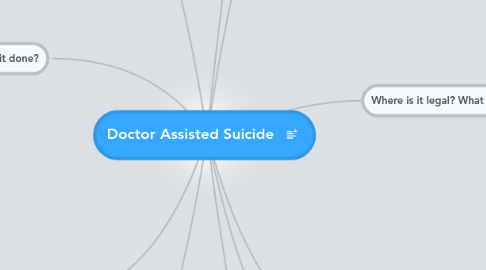Doctor Assisted Suicide
by April Alllison


1. PAS the doctor only prescribes the dosage.
2. How Is it being portrayed in the media? When did it become a topic of debate?
2.1. The first such bill introduced in the United StatesThe first such bill introduced in the United States was in 1905
2.2. ethical debate
2.3. Kevorkian
3. How common is it? how is it done?
3.1. mostly used to escape psychological distress- not physical pain
3.2. In Oregon, between 1998 and 2011, 596 patients used physician-assisted suicide — about 0.2 percent of dying patients in the state.
3.3. An overdose is prescribed and taken at home.
4. Who supports it?
4.1. Roughly, one third of Americans seem to support voluntary active euthanasia or PAS no matter what the circumstances.
4.2. physicians attitudes-only 38.9% supported permitting PAS. Consistently, few physicians would be willing to perform euthanasia or PAS if either were legalized
4.3. 60.2% of terminally ill patients ssupported euthanasia or PAS in a hypothetical situation, but only 10.6% reported seriously considering euthanasia or PAS for themselves
4.4. 11.1% (27/244) of the caregivers reported that if the patient had asked them for assistance to end their lives by euthanasia or PAS they would help. Even among the caregivers who found euthanasia or PAS ethical for unremitting pain, only 17.9% (23/128) were willing to assist with euthanasia or PAS.
5. physician assisted suicide versus euthanasia
5.1. Euthanasia- the doctor administers the dose.
6. The AMA "strongly opposes any bill to legalize physician-assisted suicide" because the practice is "fundamentally inconsistent with the physician's role as healer."
7. it protects people who do not want to suffer lingering, painful deaths it is in keeping with respect for patient autonomy it is defensible as policy because it respects social diversity it protects against physician paternalism and unwanted treatment it protects against debilitating conditions not easily managed by medicine the state has no interesting in forcing the prolongation of life of someone in pain who wants to die
8. Where is it legal? What are the laws?
8.1. A terminally ill patient is defined as someone with six months or less to live. The patient’s terminal diagnosis and mental competency must be attested to by two doctors. Patients would have to make a request to their doctor twice orally and once in writing. The written request would have to be witnessed. A terminally ill patient is defined as someone with six months or less to live. The patient’s terminal diagnosis and mental competency must be attested to by two doctors. Patients would have to make a request to their doctor twice orally and once in writing. The written request would have to be witnessed.
8.2. Montana, Washington, oregon
8.3. Supreme Court Decisions
8.3.1. Vacco v. Quill and Gregoire v. Glucksberg. In those cases, the court determined that there was no Constitutional right to physician-assisted suicide, either on the groundsVacco v. Quill and Gregoire v. Glucksberg. In those cases, the court determined that there was no Constitutional right to physician-assisted suicide, either on the grounds of equal protection or personal liberty. of equal protection or personal liberty.
8.3.2. the Court concluded that while there was no Constitutional right to physician-assisted suicide, the states of the Union could decide the matter for themselves.
